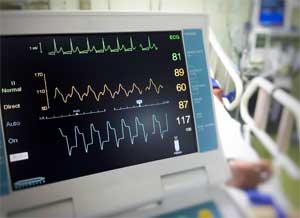- Home
- Editorial
- News
- Practice Guidelines
- Anesthesiology Guidelines
- Cancer Guidelines
- Cardiac Sciences Guidelines
- Critical Care Guidelines
- Dentistry Guidelines
- Dermatology Guidelines
- Diabetes and Endo Guidelines
- Diagnostics Guidelines
- ENT Guidelines
- Featured Practice Guidelines
- Gastroenterology Guidelines
- Geriatrics Guidelines
- Medicine Guidelines
- Nephrology Guidelines
- Neurosciences Guidelines
- Obs and Gynae Guidelines
- Ophthalmology Guidelines
- Orthopaedics Guidelines
- Paediatrics Guidelines
- Psychiatry Guidelines
- Pulmonology Guidelines
- Radiology Guidelines
- Surgery Guidelines
- Urology Guidelines
Subclinical atrial fibrillation strongly associated with HF : ASSERT Trial

Progression of subclinical atrial fibrillation (SCAF) in patients with a pacemaker or defibrillator, is strongly associated with heart failure (HF) hospitalizations, suggests an analysis of the ASSERT trial. Findings of the study are published in the Journal of the American College of Cardiology.
Jorge A. Wong, Division of Cardiology, Population Health Research Institute, McMaster University, Hamilton, Ontario, Canada, and colleagues conducted the study to examine the relationship between progression from shorter to longer SCAF episodes and HF hospitalization.
Long-term continuous monitoring detects short-lasting, subclinical atrial fibrillation (SCAF) in approximately one-third of older individuals with cardiovascular conditions. The relationship between SCAF, its progression, and the development of heart failure (HF) is unclear.
Read Also: Digoxin continues to be useful in AF with heart failure-Dr KK Talwar
Subjects in ASSERT (Asymptomatic Atrial Fibrillation and Stroke Evaluation in Pacemaker Patients and the Atrial Fibrillation Reduction Atrial Pacing Trial) were ≥65 years old, had a history of hypertension, no prior clinical AF, and an implanted pacemaker or defibrillator.
The researchers examined patients whose longest SCAF episode during the first year after enrollment was >6 min but ≤24 h (n = 415). The relationship between the subsequent development of SCAF >24 h or clinical AF and HF hospitalization was evaluated using time-dependent Cox models.
“This study is the first to demonstrate that progression of AFib, even at its asymptomatic, subclinical stage can be associated with adverse outcomes,” Wong and colleagues wrote. “As prior studies using implanted cardiac devices suggest that up to 85 percent of AFib is not clinically recognized, the current analysis of SCAF adds significantly to our understanding of the relationship between AF and HF, identifying a subgroup of patients who might benefit from preventive strategies.”
Key Findings:
- Over a mean follow-up of 2 years, 65 patients (15.7%) progressed to having SCAF episodes >24 h or clinical AF (incidence 8.8% per year).
- Older age, greater body mass index, and longer SCAF duration within the first year were independent predictors of SCAF progression.
- The rate of HF hospitalization among patients with SCAF progression was 8.9% per year compared with 2.5% per year for those without progression.
- After multivariable adjustment, SCAF progression was independently associated with HF hospitalization.
- Similar results were observed when we excluded patients with prior history of HF or when SCAF progression was defined as development of SCAF >24 h alone (HR: 3.68; 95% CI: 1.27 to 10.70).
“Detecting subclinical A-fib on an implanted device is akin to having X-ray vision into a patients’ protoplasm, knowing that health is likely not going in the right direction,” writes, Taya Glotzer, Hackensack University Medical Center, NJ, in an editorial accompanying the study. “Therefore, at a minimum, when [it] is detected, lifestyle modifications should be made wherever possible: weight should be lost to modify obesity; therapies to treat sleep apnea should be implemented and used consistently; alcohol excess should be curtailed; smoking should be stopped; glucose levels in diabetics should be carefully controlled; and medications for coexisting conditions such as hypertension should be optimized to prevent disease progression.
“That, in itself, should lead to decreases in hospitalizations and morbidity for both A-fib and congestive heart failure,” Glotzer concludes.

Disclaimer: This site is primarily intended for healthcare professionals. Any content/information on this website does not replace the advice of medical and/or health professionals and should not be construed as medical/diagnostic advice/endorsement or prescription. Use of this site is subject to our terms of use, privacy policy, advertisement policy. © 2020 Minerva Medical Treatment Pvt Ltd